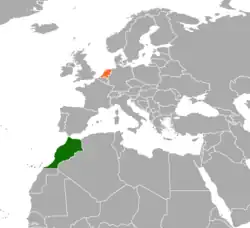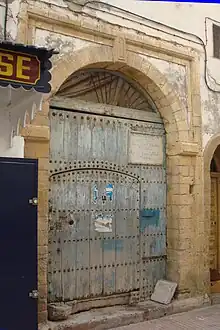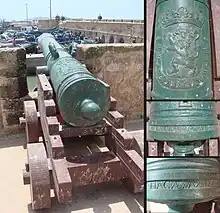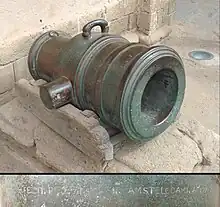Morocco–Netherlands relations
Morocco–Netherlands relations the Morocco–Netherlands relations refers to relations between the Moroccans people and the Dutch people of the Kingdom of the Netherlands which span a period from the 16th century since the Dutch Revolt period and era of Dutch Empire and Dutch Republic to the present. The relations of friendship historical and common historical alliance between the Moroccan people and the Dutch people It is an old friendship were strengthened during the reign of William the Silent and Maurice of Orange the founding father of the dynasty House of Nassau the House of Orange-Nassau and the Kingdom of the Netherlands. also the Dutch-Moroccans is the third largest ethnic group in the country. Morocco is represented in the Netherlands by an embassy in The Hague, as well as four consulates-general in Amsterdam, Rotterdam, 's-Hertogenbosch, and Utrecht. The Netherlands is represented in Morocco by an embassy in Rabat and a consulate-general in Casablanca.
 | |
Morocco |
Netherlands |
|---|---|
Country comparison
| Metric | ||
|---|---|---|
| Area | 446,550 square kilometres (172,410 sq mi) (710,850 square kilometres (274,460 sq mi) with Western Sahara) | 41,865 square kilometres (16,164 sq mi)[1] |
| Population | 36,472,000 (2019 estimate)[2] | 17,469,635 (2020 estimate)[3] |
| Population Density | 50.0/km2 (129.5/sq mi) | 423/km2 (1,095.6/sq mi) |
| Capital | Rabat | Amsterdam |
| Largest City | Casablanca (220 km2) (80 sq mi) | Amsterdam (165.76 km2) (64.00 sq mi) |
| Government | Constitutional monarchy | Constitutional monarchy |
| Official Languages | Arabic, Berber | Dutch |
| Religion | 99% Sunni Islam, 1% Other | 54.1% No religion, 38.3% Christianity, 5% Islam (Mostly Sunni), 2.6% Other |
| Ethnic groups | 99% Arab-Berber | 75.75% Dutch, 7.90% Other Europeans, 2.39% Turkish, 2.35% Moroccan, 2.05% Indonesian, 2.05% Surinamese, 0.91% Antillean, 0.61% Syrian, 5.99% Other |
| GDP (Nominal) | US$122.458 billion[4] | US$1.012 trillion |
| GDP (PPP) | US$332.358 billion[4] | US$1.055 trillion |
| GDP (Nominal) per capita | US$3,441[5] | US$58,003 |
| GDP (PPP) per capita | US$9,339 (2019 estimate)[4] | US$60,461 (2021 estimate) |
| Human Development Index (HDI) | 0.686 (121st)[6] | 0.944 (8th) |
Treaty of Friendship and Free Commerce (1610)

From the end of the 16th century, the Netherlands had been attempting to establish friendly relations with Islamic countries, such as the Ottoman Empire and Morocco, due to their common enmity with Spain.[7]

Some meagre attempts took place under Ahmad al-Mansur until his death in 1603. In April–May 1605, Pieter Marteen Coy returned to Safi in Morocco and Algiers 135 Muslim captives, both Turkish and Moorish, who had been seized by the Dutch in a naval encounter with Spanish galleys. From 1605, Coy became representative of the States General in Marrakesh.[8]
From 1608, the new Moroccan Sultan Mulay Zidan, developed a Treaty of Friendship with the Low Countries, and sent several envoys there, such as Samuel Pallache (and other members of the Pallache family), Hammu ben Bashir,[9] Muhammad Alguazir, Al-Hajari and Yusuf Biscaino.[7][10] As a result of these exchanges, the Dutch are known to have sent 3 warships requested by Mulay Zidan.[7][9] Philip III of Spain used these military exchanges as one of the justifications for his expulsion of the Moriscos from Spain in 1609.[9]
A "Treaty of Friendship and Free Commerce" was signed between the two countries in December 1610, offering "free access and friendly reception for their respective subjects with any need for safeguard or safe-conduct, no matter how they come to the others' territory".[7][9]
In 1613, Al-Hajari visited the Dutch Republic, which he could visit freely due to the existence of a Treaty of Friendship. He stayed from June to September.[10] He discussed with the Dutch Prince Maurice of Orange the possibility of an alliance between the Dutch Republic, the Ottoman Empire, Morocco and the Moriscos, against the common enemy Spain.[11] His book mentions the discussion for a combined offensive on Spain,[12] as well as the religious reasons for the good relations between Islam and Protestantism at the time:
Their teachers [Luther and Calvin] warned them [Protestants] against the Pope and the worshippers of Idols; they also told them not to hate the Muslims because they are the sword of God in the world against the idol-worshippers. That is why they side with the Muslims.
The two countries also had a short war called the Dutch-Moroccan War (1775-1777), however despite this war the countries continued having great relations throughout history.
Islamic studies

Religious discussions also occurred. The early embassy of Hammu ben Bashi in late-1609 early-1610, led to the redaction of a polemical pamphlet about Christology entitled Inquisitio et responsio quae fuit inter Mahumetitsam et Christianum de Mesia ad intelligendum an ille sit filius Dei nec ne ("Investigation and its response, which has come about between a Muhammedan and a Christian in order to understand whether or not the Messiah is he son of God").[9]
One of the ambassadors, Yusuf Biscaino, met with Prince Maurice of Nassau who inquired to him about Islamic opinions on Jesus. He preferred not to answer on the spot, but later sent a letter to Maurice.[14] After returning to Marrakesh, Yusuf Biscaino sent the letter in Latin to Maurice in 1611, relying as a source on the work of Muhammad Alguazir.[14]
One of the effects of these exchanges was the remarkable development of Arabic and Islamic studies in the Netherlands, exemplified by the work of Thomas Erpenius.[9] Thomas Epernius was able to advance his knowledge of Arabic through direct exchanges with Moroccan envoys, such as Al-Hajari.[9] Al-Hajara had used the Treaty of Friendship in order to visit the Netherlands freely after a sojourn in France.[9] Thomas Epernius became professor of Oriental Languages at Leiden University in 1613.[9]
Dutch embassy of 1640
A Dutch embassy led by Antonius de Liedekerke visited the king of Morocco Mohammed esh Sheikh es Seghir in 1640. The embassy was accompanied by the engraver Adriaen Matham who left numerous drawings, including an engraving of the El Badi Palace, before it was destroyed.[15]
In 1644, Michiel de Ruyter visited the coast of Morocco and traded there extensively.[16]
2017 diplomatic row
On 25 June 2017, the Moroccan Ministry of Foreign Affairs recalled summoned its ambassador in the Netherlands as a gesture of protestation, that came after Said Chaou, a Moroccan dissident established in the Netherlands, appeared in a Facebook live video, commenting the current events in the Hirak Rif. The Moroccan side reiterated its wishes to see Chaou extradited to Morocco where an arrest mandate has been issued for him since 2010, by judge Nourreddine Dahen.[19] The Dutch response was that whilst it was committed to cooperation with the Moroccan government in strict respect of international law, it considered the reaction of the Moroccan government "incomprehensible and futile".[19]
See also
Notes
- Kruijtbosch, E. D. J. (1969), "Naar Een Sociaal En Economisch Verantwoorde Ruimtelijke Ordening in Nederland", De ruimtelijke ordening, Dordrecht: Springer Netherlands, pp. 1–33, ISBN 978-94-015-0096-8, retrieved 2021-05-09
- "Morocco - Total Population". Knoema. Knoema. Retrieved 13 May 2020.
- "CBS Statline". opendata.cbs.nl (in Dutch). Retrieved 2021-05-09.
- "World Economic Outlook Database". International Monetary Fund (IMF). International Monetary Fund (IMF). Retrieved 13 May 2020.
- "World Economic Outlook Database". International Monetary Fund (IMF). International Monetary Fund (IMF). Retrieved 13 May 2020.
- ""Human Development Report 2019" (PDF)". United Nations Development Programme. United Nations Development Programme. 10 December 2019. Archived from the original on 30 April 2020. Retrieved 13 May 2020.
- Poetry, politics and polemics by Ed de Moor, Otto Zwartjes, G. J. H. van Gelder p.127
- In the lands of the Christians: Arabic travel writing in the seventeenth century by Nabil I. Matar p.44 Notes 38–39
- Romania Arabica by Gerard Wiegers p.405ff
- Romania Arabica by Gerard Wiegers p.410
- The mirror of Spain, 1500–1700: the formation of a myth by J. N. Hillgarth p.210ff
- In the Lands of the Christians by Nabil Matar, p.37 ISBN 0-415-93228-9
- In the Lands of the Christians by Nabil Matar, p.37 ISBN 0-415-93228-9
- European converts to Islam in the Maghreb by Mercedes García Arenal p.211
- Marrakesh: The Secret of Courtyard Houses Quentin Wilbaux p.95ff
- A History of the Jews in North Africa Haim Zeev Hirschberg, Eliezer Bashan, Robert Attal
- Zaken, Ministerie van Algemene (2018-02-21). "Embassy of the Kingdom of Morocco ('s-Gravenhage) - Embassies, consulates and other representations - Government.nl". www.government.nl. Retrieved 2022-03-02.
- "The Dutch Embassy in Rabat | Morocco". www.nederlandenu.nl. Retrieved 2022-10-04.
- "Affaire Said Chaou : Les Pays-Bas rejettent la demande marocaine". Yabiladi. 25 June 2017. Retrieved 29 June 2017.



